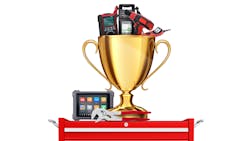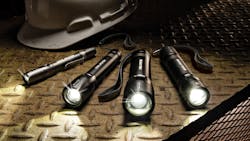A commercial vehicle maintenance team is only as good as the people within it. And those workers are only as productive and successful as the tools and equipment at their disposal allow. With the right tools, technicians will be at their most efficient—providing faster throughput with fewer repeat repairs—to achieve higher vehicle uptime.
Fleet Maintenance spoke with industry award-winning technicians as well as maintenance managers of successful repair operations to better understand how to outfit technicians and the shop with the tools and equipment that will establish the most efficient maintenance environment.
Shop essentials
So, what do the best techs and management alike consider the essentials to get the work done?
Diagnostic tools
“Number one, hands down, would have to be our OEM diagnostic computer,” said Chris Purcell, service technician at Rush Truck Centers—Atlanta. Purcell, Grand Champion of Rush’s internal technician competition, the All-Around Tech Skills Rodeo, stated that diagnostic software is utilized day-in and day-out, multiple times a day—if not on every job, then almost every job.
“We run health reports and use internet access for troubleshooting, wiring diagrams, and things of that nature,” he said.Purcell said while working at this International dealer location he mainly uses the OEM’s EZ-Tech software, which includes multiple applications. He and his shop also use an all-makes software as well, but he mentioned the clear distinctions between the two.
“The OEM diagnostic software gives you detailed code descriptions,” he related. “There are multiple diagnostic tests you can run. You can do snapshot recordings to help you identify different failures. The generic software typically gives you a fault number, and then it’s up to you to look it up from there. There may be a few minor diagnostic tests it will let you do—maybe a forced regen and things like that; some resets—but you’ve definitely got more access with OEM software. It helps to have an all-in-one versus having to go from here to there.”
Purcell and his team in Atlanta aren’t the only ones relying on OE diagnostic software. Bonnie Greenwood, senior shop technician at FedEx Freight’s Salt Lake City, Utah, location also ranks diagnostic laptops and adapters amongst her most essential tools. Recently, Greenwood placed second at TMCSuperTech, the annual American Trucking Associations’ Technology and Maintenance Council’s National Technicians Skills Competitions—the highest ranking ever for a female in the competition’s 17-year history. She was also the first female TMCFutureTech champ.
“I use this setup to diagnose issues and fault codes on tractors, daily,” she related. “This equipment allows me to quickly assess which ECUs are present and communicating, pull fault codes, and then access any OEM program for further diagnostics.”
Ryder Systems’ 2022 Ryder Top Tech winner, Christopher Johnson, a technician out of Annacis Island, Delta, British Columbia, Canada, said his favorite tool is his SBT diagnostic laptop, a Dell Toughbook—a tool he uses every day in some form or another. Johnson related that he uses the laptop and its software to get vehicle health reports during services and diagnostic sessions.
“The most powerful feature is the OEM software that is installed on it,” Johnson said. “Being able to diagnose, run tests, monitor values, and change parameters is extremely powerful. My main use is in the diagnosis of check engine lights and other vehicle warning lights such as ABS, traction control, and driver safety systems.
“The diagnostic laptop helps in promoting vehicle uptime by allowing us to accurately scan vehicle systems and diagnose the problem correctly the first time, and thus keeping the vehicle on the road,” Johnson reinforced.
Technicians aren’t the only ones who highly prize diagnostic software in the shop.
“Our number one tool that promotes uptime is that OE software, that diagnostic laptop,” concurred Mark Kanitz, service manager at Rush Truck Centers—Houston. “A large percentage of everything that’s rolling into our service department requires that we are communicating in some capacity with a module or a computer on that truck. And so, it really serves as a starting point to make a determination as far as what that repair path may look like.”
Kanitz related that the software is used on services from engine repair to transmission repair, collision mitigation systems, and anything in between. And from a managerial perspective, Kanitz said that it is up to him to equip his technicians (more than 50 at the Houston-based shop) with the software relevant to their area of expertise.
“We have techs who tend to gravitate to a certain area and aspect of the truck, and they are more proficient with that,” he said. “We have a technician who’s very proficient with transmissions and gear work. I’m going to ensure that his diagnostic laptop has maybe Eaton’s ServiceRanger and Peterbilt’s ESA (Electronic Service Analyst) as the OE software. But it may not make sense for me to have him fully equipped with an engine program that he’s not working on day-in and day-out.”
Kanitz’s shop employs a divide-and-conquer tactic—with the software divided and supplied to techs as needed for the specialist work they do. But this doesn’t happen overnight, and it takes careful management and development to get a team equipped to execute repairs efficiently.“When we get a technician started, we try to figure out where they excel most,” Kanitz explained. “And that is when we look at it from a shop management standpoint. I want to get those guys in environments where they’re going to succeed and grow. And then from there, as they continue their career with us, we look at trying to expand their knowledge and get them introduced to other areas that maybe they haven’t had that natural inclination towards.”
Regardless of where a tech is proficient, it is paramount they are familiar and comfortable with diagnostic software from the start.
“You think back to your typical diesel truck or heavy-duty truck compared to what it was, say 30 or 35 years ago, when everything was mechanical—to now,” said Victor Cummings, Rush Enterprises VP of service operations. “The truck has become very complex.”
Cummings added that technicians can no longer get by just working on mechanical components if they hope to be strong contributors to a winning shop.
“You have got to have some level of comfort with the computer, and that has presented some challenges, but nevertheless, that is where we are today,” Cummings emphasized.
Cummings also related that all-makes diagnostic software has its place in the service bay as well. “We are very diverse in what we work on, and we work on far more than just our own brand at every Rush Truck Center dealership,” he said. “So, we do purchase and use all-makes diagnostic software.” Cummings said that Rush uses TEXA across many locations but offered some insight on how individual shops can determine the best all-makes option for their operations: Shops should bring in different software and let the technicians pilot them to find out which is most effective for the work they do.
James Rolsing, operations manager at Ryder, stated that he prefers the service bay tools from Noregon Systems as his choice of all-makes diagnostic software.
Rolsing and team use the software to diagnose check engine lights from various manufacturers, among other processes, multiple times a day. He appreciates the “step-by-step” diagnostic procedures provided and the software’s ability to work on multiple manufacturers from the same tool.
“[It is an] all in one,” he said. “[We] do not need multiple scan tools and manuals.”
Column lifts
Kanitz stated that his shop has seen tremendous efficiency gains using wheel lifts, or column lifts, as his shop leverages the equipment for both engine and chassis repairs.“Having a good set of wheel lifts—because oftentimes you may be accessing the bottom end of the engine, or you may happen be pulling out a transmission—really helps from an efficiency standpoint. Being able to get the unit up safely and also being able to get in and out of that quickly is definitely a big benefit,” he said. “That helps a lot from an efficiency standpoint versus putting your technicians in a scenario where they are having to try to figure out, ‘How do I get in and out from under the vehicle?’ or ‘How do I remove a component and get it out from under the vehicle?’”
Because of the size of his shop, Kanitz said they have multiple sets of column lifts, and that on any day one may see four sets being utilized at a time.
Cummings related that Rush uses a mix of Gray Manufacturing and Rotary lifts throughout its network, and often both within some shops.
“I absolutely love those things simply because they’re very efficient in terms of getting access to the part of the vehicle that you’re attempting to service, but also, they’re very safe,” he continued, speaking on column lifts. “I have a much higher comfort level having our technicians under a vehicle using column lifts than your typical jack stand configuration. That’s why they are my favorite tool because of the safety and efficiency that they bring.”
Rolsing agreed column lifts are efficient
pieces of equipment. His preference is Stertil-Koni’s Mobile Column Lift, No. ST 1075. Rolsing said the lifts are used for plenty of repairs such as clutch or transmission work, driveline repairs, starter replacements, preventive maintenance, and so much more.
As Ryder shops use the lifts daily, promotion of efficiency is crucial with the equipment. Rolsing said such efficiency is achieved through the lifts’ ability to allow the technicians to operate in a standing position versus on their back, on a creeper. “Plus, with low profile vehicles, it is the easiest way to get underneath,” he added.
Technician essentials
Beyond shop equipment and software subscriptions, technicians must use a litany of tools to execute their duties on a regular basis. However, some tools stand out from the pack as to their importance and impact on a technician’s ability to do their best work.
Electrical service tools
FedEx Freight’s Greenwood said her number one essential tool is a multimeter of any reputable brand.
“Typically, I use my multimeter every day for electrical troubleshooting on everything from forklifts to tractors, and for anything from lighting issues to engine fault codes,” she said. “My multimeter allows me to get to the root of electrical problems quickly so that repairs can be made in an effective manner.”Greenwood related that the multimeter she uses today is the same model she used back in trade school, as she is comfortable using it and knows she can trust the readings.
Rush’s Purcell said a good digital voltmeter is essential; and he isn’t so much brand specific when it comes to the tool, but just needs it to be of quality.
“There are so many sensors and different systems on vehicles now, whether it’s engine, transmission—everything is electronic,” he said. “You have got to have a good voltmeter to do the voltage checks, resistance checks, and things of that nature.”
At the top of Purcell’s checklist when determining the best voltmeter to choose from is auto ranging capabilities. Furthermore, he makes sure he has a wide range of test leads to avoid damaging connectors.
Ryder’s Johnson concurred that multimeters are a must-have. His favorite is Mac Tools’ Digital Multimeter, No. EM710, as it has excellent battery life, he attested.Johnson uses his multimeter for diagnosing electrical systems from simple light circuit faults to complicated CAN datalink communication faults. Though his use of the tool varies from several times a week to several times a day, he emphasized the importance of having one handy, as it promotes vehicle uptime “by being able to diagnose electrical systems and circuits in an efficient manner and locate the fault. This keeps the vehicle on the road and prevents repeat shop visits.”
Rolsing posed another electrical service essential: the AutoMeter Heavy Duty Truck Electrical System Load Tester, No. BCT-460.
He said the handheld battery and electrical system analyzing tool is used multiple times a day, and is “easy to use, faster, and way more user-friendly.
“[It is a] wireless, portable tablet with step-by-step procedures and pictures, [and] information is sent to the cloud for all to use as needed,” he added.
Cordless power tools
Eric Moore, fleet manager at Griffin Pavement Striping in Columbus, Ohio—a business that has been successfully operating since 1977—related that he and his team consider cordless tools atop their essentials for commercial vehicle repair. More specifically, the Milwaukee Tool M18 FUEL 1/2” High Torque Impact Wrench with Friction Ring, No. 2767-20.
“Just about every job on our equipment has large fasteners that need [to be] loosened or removed for repairs or maintenance,” Moore explained. “Once the problem has been identified, it is pretty much automatic to reach for the M18 FUEL impact and the sockets to do the job.
“There are too many repairs that call for the High Torque Impact on our equipment, but I’d say the most common is removing 22.5-inch wheels, either for access to another component, or to switch out worn tires,” he continued.
The impact is used every single day, multiple times a day, Moore said, and the freedom from cords or air lines helps promote efficiency. He also said that the amount of available torque for removal or assembly is excellent.FedEx Freight’s Greenwood further attested to the importance of cordless power tools. She uses a cordless 1/2” impact to remove lug nuts and a 3/8” impact for smaller disassembly/assembly projects—which ends up being nearly every job, she added.
“The batteries last for a long time on a single charge, are compatible with a wide variety of tools, and allow for quick repairs,” she continued. “They are dependable, resilient pieces of equipment that allow more versatility than pneumatic tools.”
Flashlights
Moore and the team at Griffin Pavement Striping consider the pocket flashlight as the number one essential for commercial vehicle repair.
“It is the tool each one of my technicians makes sure to have at all times,” he said. “[It is used] on every single vehicle, every single time.”
As to a specific favorite of the shop, three out of five technicians at Griffin Pavement Striping carry the 100-lumen Blue-Point Penlight from Snap-on.“The pocket lights are critical for diagnosis of leaks,” Moore continued, “because most [leaks] are not immediately evident in an open place, [nor] easy to get to; they are always buried under or inside of other areas. Being able to light up the area in question makes quick work (usually) of finding the leak and identifying the best way of repairing it.”
Moore and team said the benefit of not having to drag around corded lighting equipment to each job means that diagnosis can take place wherever the vehicle is located. “No wasted movement,” Moore reinforced.
Furthermore, he said that pocket lights’ compact size and resilience are another benefit, as they are constantly dropped or covered in fluids, and still get the job done.
Adjustable wrenches
Moore and team also raise another essential: adjustable wrenches.
“We have so many types of equipment and with all the different size fasteners, it’s just easiest to grab an adjustable wrench so you won’t have to walk back to the toolbox several times just to tighten, loosen, or adjust something on one of our vehicles or equipment,” Moore stated. “We use the adjustable wrench so much, we have about 12 of them hanging right by the overhead door most often used for entry and exit while crews are prepping for the daily projects.”Also used on every piece of equipment every single day, Moore said that the ability to stay on task instead of wasting time changing tools is a huge benefit of the adjustable wrenches. Further, Moore said there is value in adjustable wrenches that feature knurled finishes on the interior jaws as they will grip fasteners more securely and prohibit (though, not completely prevent) rounding of the fasteners.
Outfitting considerations
Rush’s Purcell said that financial responsibility plays a big role in determining technicians’ decisions when it comes to outfitting their toolbox.
“From a technician standpoint, you’ve got different levels [of experience]: people just starting out and people who have been doing this for 20 years,” Purcell said. “But there comes the financial side of it. You have to be able to get what you can afford, but you also want to buy something that is going to last you long term… Get what you can afford and upgrade when you can.”
Kanitz related that as a manager, priorities go beyond just upfront expenses.
“From a managerial standpoint, the things that I’m looking for are a little different than what Chris is referring to on a per-tech basis,” he said. “We don’t expect our technicians to stomach the expense of a specialized breakout harness; the shop is going to help in purchasing and making the tooling available. From my perspective, I’m looking at one: safety. Safety is a big one; whatever we’re going to buy, we want to make sure that it is of quality, and it is safe.
“Two: I’m going to look at overall dependability and the frequency of the usage,” Kanitz continued. “Yes, cost comes into play. But I always say, ‘You can’t afford to buy cheap,’ because I don’t want to buy it four times; so, I may spend a little bit more on that front side.
“As a dealer, one of the other things I look at a lot too is what kind of warranty and support are we going to get from a tooling vendor,” Kanitz continued. “If I have an issue with something that fails, are they going to be able to adequately support it and service it? Are they going to back us up? If I’m going to spend several thousand dollars on a tool, I want to know that I’m going to have service that goes with it as well.”
Kanitz relayed his decision-making process, saying if two tools cost the same, he wants to understand the return he will yield, specifically in opportunities to gain efficiency.
Cummings agreed that supplier support is a major factor when it comes to determining where to purchase. “I want to know that we’re doing business with a supplier that is going to be here, that has been here, that I can depend upon,” he said.
And beyond support, Cummings said that understanding the ROI, as well as opportunities for business additions, are crucial aspects in equipping the service team.
“From the business perspective, we’re always looking at return on investment,” Cummings concluded. “There are tools we don’t use frequently enough; sometimes it makes more sense to sublet certain parts of a job out. However, if we’re confident we can make the return, and if we need it, we get it. If we know we can generate good business on a tool, cost is not the overriding factor. It comes down to this: Are we going to use it? What’s the return? Then, let’s go out there and get the business.”
About the Author
Tyler Fussner
Associate Editor | Fleet Maintenance
Tyler Fussner is Managing Editor - Community Manager at Supply Chain Connect, part of the Design & Engineering Group at Endeavor Business Media.
Previously, Fussner served as the Associate Editor for Fleet Maintenance magazine. As part of Endeavor's Commercial Vehicle Group, his work has been published in FleetOwner magazine, as well as Bulk Transporter, Refrigerated Transporter, and Trailer-Body Builders.
Fussner's May 2022 print feature 'The dawn of hydrogen trucks' was named the best single technology article in B2B by the judges of the 2022 Folio: Eddie and Ozzie Awards. Fussner was also awarded Silver in the Technical Article category for the Trade Association Business Publications International (TABPI) 2021 Tabbie Awards.
Fussner previously served as Assistant Editor for Endeavor's Transportation Group on the PTEN, Professional Distributor, and VehicleServicePros.com brands.
Fussner studied professional writing and publishing at the University of Wisconsin-Whitewater. He has experience in shop operations, is a Michelin Certified Tire Technician, and a Michelin Certified Tire Salesperson.










